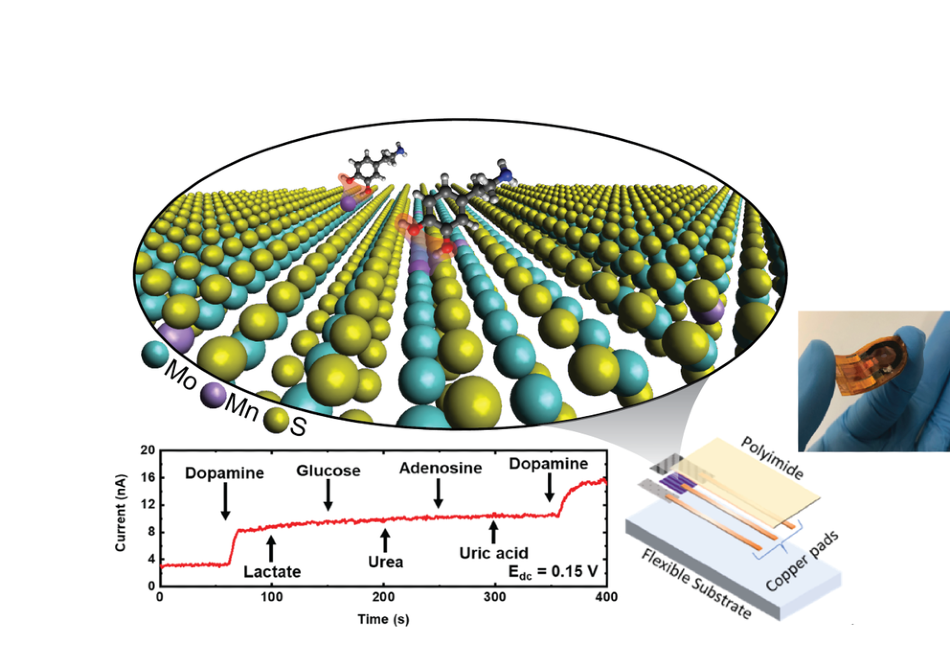Aug 10 2020
According to a team of researchers, headed by The Pennsylvania State University (Penn State), Rensselaer Polytechnic Institute, and universities in Japan and China, a supersensitive dopamine detector can facilitate early diagnosis of many disorders that lead to too little or too much dopamine.
 Schematic of a highly selective dopamine detector using two-dimensional material. Image Credit: Derrick Butler, The Pennsylvania State University.
Schematic of a highly selective dopamine detector using two-dimensional material. Image Credit: Derrick Butler, The Pennsylvania State University.
Dopamine is a crucial neurotransmitter that can be used for diagnosing several disorders such as schizophrenia, Alzheimer’s disease, and Parkinson’s disease.
If you can develop a very sensitive, yet simple-to-use and portable, detector that can identify a wide range of dopamine concentration, for instance in sweat, that could help in non-invasive monitoring of an individual’s health.
Aida Ebrahimi, Study Corresponding Author and Assistant Professor, School of Electrical Engineering, The Pennsylvania State University
The study was published in the Science Advances journal on August 7th, 2020.
The study demonstrates that when a small quantity of manganese is added to a two-dimensional (2D) layered material, known as molybdenum disulfide, the sensitivity can be enhanced by many orders of magnitude when compared to other results reported to date, and at the same time, high specificity can be achieved.
Most significantly, the detector developed by the team is flexible and economical, and can identify dopamine present in background media, such as sweat, serum, and buffer, and in real-time.
Regarding our method, electrochemical deposition is a new way of depositing these chemicals that is very simple and scalable. The air force is interested in these neurotransmitters that are makers of stress. I envision this as a wearable sensor.
Verne M. Willaman, Professor, Departments of Physics, Materials Science and Chemistry, The Pennsylvania State University
Professor Willaman is also the second corresponding author of the study.
Along with his research team from Rensselaer Polytechnic Institute, Humberto Terrones conducted the computational analysis that allowed them to describe how the response to dopamine is improved by adding manganese. This experimental study was carried out inside the Center for Atomically Thin Multifunctional Coatings (ATOMIC) at Penn State.
Combining the experimental results with computational studies proved to be very insightful, and I think we all learned much more throughout this project because of that. Developing these materials and applying them in a way that could improve the health and well-being of others makes the work especially enjoyable and rewarding.
Derrick Butler, Study Co-Lead Author and Doctoral Student, The Pennsylvania State University
Yu Lei, Butler’s co-lead author and doctoral candidate, added, “One challenge is to develop a scalable method to bridge fundamental studies and practical applications. Our method is based on electrodeposition, which has been widely used in industry, thus providing a scalable route to functionalize MoS2 in a scalable way. Also, I believe this multidisciplinary team is the key to find the right way to functionalize MoS2 for ultrasensitive dopamine detection.”
The researchers will perform more studies in which they hope to identify other combinations of material to identify a range of other biomarkers that have the specificity of their present-day sensor.
Producing such a “toolkit” that combines computational techniques with experimental analyses will result in novel materials that have multifunctional capabilities. This may prove handy apart from human health—for instance, for identifying biodefense agents, water contamination, or harmful gases.
“In future, we can envision a combined sensor/actuator that can detect the dopamine and provide therapy at the same time. The sensors can be integrated with miniaturized chips for integration of sensing, actuating, control and data processing,” concluded Ebrahimi.
Apart from Ebrahimi, Lei, Butler, and the Terrones brothers, other authors of this study are Fu Zhang and Tomotaroh Granzier-Nakajiwa, former and current doctoral students from Penn State, and Kazinora Fujisawa, presently a post-doctoral scholar in Penn State.
The project was financially supported by the National Science Foundation, IUCRC-ATOMIC Center, and Ebrahimi’s Start-up fund.
Journal Reference
Lei, Y., et al. (2020) Single-atom doping of MoS2 with manganese enables ultrasensitive detection of dopamine: Experimental and computational approach. Science Advances. doi.org/10.1126/sciadv.abc4250.